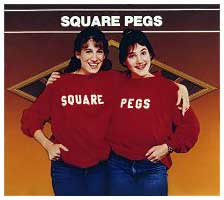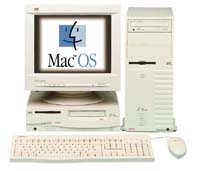Mac Musings
One Size Does Not Fit All: Mac Solutions for the Entry Level
Daniel Knight - 2004.05.05
Last week we looked at several ways of addressing areas that make it hard to market the Mac to a broader audience. The Mac is seen as too different, overpriced, not expandable, incompatible with Windows, and generally not recommended by the "experts" people ask for advice when buying a new computer.
One solution that just about every writer on the Mac Web has suggested at one time or another is a low-cost modular Mac, sometimes called a headless iMac. My suggestion last week was a single model with a lot of upgrade potential.
Now I see another way.
 One Size Does Not Fit All
One Size Does Not Fit All
Remember Square Pegs, a delightfully quirky show that starred Sarah Jessica Parker in the 1982-83 season - long before she discovered sex in the city? The theme song, performed by The Waitresses, repeated the line, "One size does not fit all." (Available from the iTunes Music Store for just 99¢.)
Just as that justifies the existence of the Mac OS, Linux, and other operating systems in a world dominated by Windows, it also means that one Mac won't meet the needs of every user - especially not on the low end.
I tried to come up with a one-size-fits-all solution last week, and several readers called me on it. I wasn't thinking far enough outside the box. As I was researching my Dell OptiPlex GX1 over the weekend (where do they come up with these names?) to learn how I could overclock it (answer: it doesn't seem to be possible), I discovered that Dell has already found a solution. Maybe Apple can learn from them this time.
 The OptiPlex GX1 came in at least
three different cases, each with different drive and card expansion
options. On the short side, the slim model (right) had only a
single optical drive bay. The standard desktop model had two
optical drive bays. The minitower (right) had three optical drive
bays. The number of expansion slots was determined by a riser card,
the same solution Umax used in their slim two-slot SuperMac C500 and minitower three-slot
C600 (below).
The OptiPlex GX1 came in at least
three different cases, each with different drive and card expansion
options. On the short side, the slim model (right) had only a
single optical drive bay. The standard desktop model had two
optical drive bays. The minitower (right) had three optical drive
bays. The number of expansion slots was determined by a riser card,
the same solution Umax used in their slim two-slot SuperMac C500 and minitower three-slot
C600 (below).
 Why should Apple limit
themselves or their users to a single configuration?
Why should Apple limit
themselves or their users to a single configuration?
History
Apple has done it before, offering the same motherboard in two different enclosures (such as the Quadra 650 desktop and Quadra 800 minitower) or the same model with different clock speeds and feature sets. With the various slot-loading iMacs, Apple sometimes had two different motherboards and four different processor speeds.
Way back in the olden days of the SE/30 and Mac IIci, Apple even sold computers without hard drives. Customers could buy a base unit with a floppy and a bit of RAM, and the dealer could upgrade it with as much memory and as large a hard drive as the user needed.
The Customizable Macintosh G4
I'm going to suggest that Apple look to its history to find inspiration for creating several lower-cost entry-level models. Let's start with two motherboards:
- Same 167 MHz system bus, CPU socket, and PC2700 memory as fastest Power Mac G4.
- Two RAM sockets on low-end board, four on high-end board. RAM expansion to 2 GB and 4 GB respectively.
- Integrated lower-end AGP 4x video with 32 MB memory on low-end board, no onboard video on high-end board.
- Riser card slot.
- Two IDE busses on low-end board (ATA66 and ATA133), three on high-end board (add ATA100).
- 10/100 ethernet on low-end board, 10/100/gigabit on high-end board.
- Dedicated slots for modem, Bluetooth, AirPort Extreme.
- USB 2.0, FireWire 400, and FireWire 800 ports on rear. USB 2.0 and FireWire 400 ports on front as well.
The two boards should be swappable in the same enclosure, making it possible for someone who buys the entry-level system to upgrade should they need additional memory slots, a third IDE bus, etc.
With onboard video, an entry-level Macintosh G4 wouldn't need a riser card at all, and Apple could design a slim case with a single optical drive bay and room for two PCI cards (or one PCI and one AGP) that could be added using a riser card later on. Total height would be about 4", just like the SuperMac C500. I'm guessing Apple could make the unit as narrow as 12", and if they forgo full-sized PCI cards the compact model could be under 16" deep.
Or make it just a bit wider and give it a handle on one side so it's easy to tote to LAN parties. And try to make it fanless if at all possible, like the slot-loading iMacs and unlike my eMac or Dell. That makes running the computer 24/7 less of an audible nuisance.
The first step up would also be a desktop model, but one with two optical drive bays and room for three expansion slots (2 PCI plus 1 AGP). The power supply would be a bit more robust to handle two optical drives plus two hard drives.
The third model would be the enclosure I suggested last week, one where the optical drive bay can be removed and rotated 90°, facilitating conversion from a desktop orientation to a minitower configuration. There should be room for three optical drives and 3-4 hard drives, along with a more robust power supply and a riser card that supports 3 PCI cards plus an AGP card.
More Markets: Digital Video
I've recently discovered just how inexpensively a Windows PC can be made into a digital video recorder. Did you know that you can add a TV tuner, such at the ATI TV Wonder VE, to a Windows PC for under US$50 from Walmart (online and possibly at your local store), have free access to TV listings, and record programs to the hard drive? All you need is a Pentium II or faster, Windows 98SE or later, and a free PCI slot.
Think that sounds cool? You ain't seen nothin' yet. The ATI All-In-Wonder cards have long been a staple on DOS and Windows PCs (yes, they do have that long a history), and the All-In-Wonder VE goes several levels beyond the TV Wonder. How about the ability to burn Video CDs and DVDs of your favorite programs? Yep, part of the package - you supply the CD or DVD burner and the software does the rest.
How about audio and video I/O ports, which the TV Wonder VE lacks? Uh huh, standard on the All-In-Wonder VE. All you need is a free PCI slot.
It gets better. This card also includes a Radeon 7500 graphics processor and 64 MB of video memory. If your old PC has pathetically outdated video and no AGP slot (like my Dell), you can get video I/O; a TV tuner; the ability to record, edit, and burn your videos; and a fairly modern video card for under US$100 (Froogle found four sources this morning)
Guess what's going in my Dell when I move to my new apartment, have broadband Internet, and can remove the modem? An All-In-Wonder VE and a 60 GB hard drive. I've already got a CD burner installed.
Want to do the same thing on your Mac? Plan on paying at least $200 for a PCI card or external FireWire device, using iMovie to do your editing, and then figuring out the best way to burn a VCD or DVD (unless you have iDVD and a SuperDrive).
This is why the compact enclosure should be whisper quiet - so the entry level Mac can be used as a DVR as well as a full-fledged Macintosh. With a DVD-ROM drive, it could replace both a DVD player and a VCR. With a Combo drive or SuperDrive, it becomes a tool for archiving your favorite programs to disc.
My suggestion would be that Apple work with ATI to develop a card similar to the TV Wonder Pro, which supports audio and video I/O and stereo sound output. Bundle this with a package that makes it easy to burn Video CDs and Super VCDs, and Apple would have a fantastic digital hub for the home.
More Markets: Shared Internet
Getting creative, how about internal cable and DSL modems? They could plug into the current modem slot on the G4 motherboard and eliminate that extra box and cables necessary for broadband access. Using the built-in ethernet port and/or an AirPort Extreme card, the Internet Sharing and Firewall software already built into OS X could both share a connection with other computers and protect the home network - no need to buy a separate router or base station.
More Markets: Music
Right now I have my Dell in my bedroom. It's a small apartment, and the only phone jacks are in the kitchen and bedroom. But it's not a quiet computer, so I don't keep it running 24/7.
I can do that with my PowerBook, and I could have done that with my Cube, but my eMac is too loud to run 24/7 in a bedroom. A whisper quiet modular Mac could replace the Dell as well as my clock radio and CD player. Add an FM tuner, and it could wake me up to my favorite radio stations at different times on different days. Or it could randomly select music from a specific playlist in iTunes.
And it could function as a music server for the home network - and a file server, too.
But it has to be quiet for that, or to function as a component in a home stereo setup. The compact Macintosh G4 could look equally at home in the stereo rack, home theater, bedroom, den, or workplace. It would be really nice if the styling made it work visually with these settings as well.
More Markets: Geeks
For those who want more expansion options, Apple can offer a larger desktop case as well as the convertible desktop/minitower case I suggested. They can up-sell people to the more expandable motherboard. They can promote this as a great low-cost server for a home or small office network. It's no Xserve, but it's inexpensive, fast enough, and simply cost-effective.
Add your own drives. Upgrade video cards. Put in two or three disc burners. Make the Macintosh your Macintosh.
More Markets: Your Next Computer
Apple's greatest potential isn't to switch people from Windows but to get Windows users to add a Mac next time they buy a new computer. Imagine offering them a computer quiet enough and energy efficient enough to leave it running 24/7 in your bedroom. Or one that can act as a file server and music server while sharing your Internet connection and acting as a firewall. Or one that makes recording, editing, and archiving your favorite TV programs easier than Dell (plus an ATI or other tuner card).
The iPod and iTunes for Windows are already showing the world how much Apple knows about product design and user interface.
The market is ready for better solutions. I hope Apple will offer them before HP/Compaq, Dell, or Gateway does.